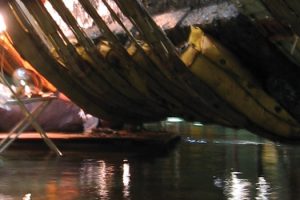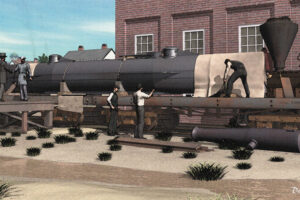(January 28th, 2005 – CHARLESTON, SC) This week, scientists began work on the removal of the wooden bench the Hunley crew sat on to crank and propel the submarine into world history. Archaeologists and conservators are hopeful that once the bench is removed, they will discover new Hunley artifacts.
Storage space for the crew’s personal belongings was extremely limited within the tight confines of the submarine. When the Hunley crew was preparing for their mission, the most logical place to store personal belongings while not interfering with the operation of the submarine was directly beneath the bench.
Senator Glenn McConnell, Chairman of the Hunley Commission said, “Up until now, the area beneath the bench was almost inaccessible. This area is also heavily concreted, which masks any artifacts that may have been stored there and makes them very difficult to remove. This is potentially a relic-rich region. I can’t help but wonder what other items the crew may have decided to take with them on a mission they knew to be dangerous and life threatening. The possibilities are limitless on what other fascinating artifacts from the 19th century the Hunley has yet to reveal.”
At this time, scientists have already identified two canteens located under the first section of the bench, and one canteen under the second section.
The bench removal is expected to be difficult and may take several weeks to complete. After being submerged in salt water for over 140 years, the bench is waterlogged and extraordinarily fragile. Additionally, approximately 50% of the bench is still covered with a clear lead based paint.
Paul Mardikian, Senior Conservator to the Hunley project said, “You are looking at the original paint from 1864. The binder (oil) has disintegrated over the years leaving the white pigments behind. The paint can literally just slide off, which makes this bench even more fragile to handle and conserve.”
Still, conservators are hopeful to maintain the bench’s original features as much as possible during excavation. Removing the bench is the beginning of the final steps needed to prepare the world’s first successful combat submarine for conservation. Before conservators can begin a treatment to eliminate salts threatening the stability of the vessel, the bench and other artifacts must be removed from the submarine so that they are protected from the effects of the chemicals used in the conservation process.
The bench is almost 18 (17.85) feet long, about one inch thick, and is made of three distinct panels of wood bound together. In order to remove the bench from the submarine, scientists are excavating the iron concretion that over time has built up around the various metal brackets holding the bench in place.
The front bench panel, approximately 6.5 feet in length, is in the forward section of the submarine and was the first to be excavated. Archaeologists anticipated this section of the bench would be the least complicated to remove due to ease of access. They also have completed removal of the second bench panel.
The third section of the bench will likely prove to be the most difficult to excavate since it is extremely difficult to access, and, in some places, is mounted within the submarine’s aft pump mechanisms.
Once the bench and other artifacts are removed, they will be safely relocated in the lab to be analyzed and stabilized.
Friends of the Hunley
On the evening of February 17, 1864, the H. L. Hunley became the world’s first successful combat submarine by sinking the USS Housatonic. After signaling to shore that the mission had been accomplished, the submarine and her crew of eight vanished.
Lost at sea for over a century, the Hunley was located in 1995 by Clive Cussler’s National Underwater Agency (NUMA). The hand-cranked vessel was raised in 2000 and delivered to the Warren Lasch Conservation Center, where an international team of scientists are at work conserving the vessel and piecing together clues to solve the mystery of her disappearance.



